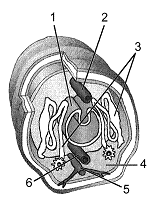In 1998, researchers found that genes similar to the Drosophila gene tinman are necessary for heart development in vertebrates. What can you conclude about the ancient bilaterian ancestor of insects and vertebrates over 500 million years ago?
A. The fly species that eventually gave rise to vertebrates used tinman to make a heart.
B. Something about heart development requires a gene to have a tinman-like sequence, but the vertebrate and invertebrate genes arose by convergent evolution -- so the ancestor had a similar but not homologous gene.
C. The ancient ancestor lacked a heart, but already had a tinman-like gene.
D. The ancestor had a heart-like structure that was specified by a tinman-like gene.
Clarify Question
What is the key concept addressed by the question?
What type of thinking is required?
Gather Content
What do you already know about the tinman gene? What other information is related to the question?
Choose Answer
Given what you now know, what information is most likely to produce the correct answer?
Reflect on Process
Did your problem-solving process lead you to the correct answer? If not, where did the process break down or lead you astray? How can you revise your approach to produce a more desirable result?
D. The ancestor had a heart-like structure that was specified by a tinman-like gene.
Clarify Question
What is the key concept addressed by the question?
· The concept addressed here are the characteristics possessed by the hypothesized ancestor of insects and vertebrates that are relevant to the development of the heart.
What type of thinking is required?
· Evaluate level:
o This question is asking you to weigh and judge, or evaluate, the bilaterian ancestor of insects and vertebrates in regards to the development of a heart.
Gather Content
What do you already know about the tinman gene? What other information is related to the question?
· The structure that functions as a heart in Drosophila is the dorsal vessel.
· The tinman gene is active in the development of the dorsal vessel.
· A similar gene has been found to contribute to the development of heart structure in vertebrates.
· The presence of this gene in both Drosophila and in vertebrates is an example of evolutionary conservation.
Choose Answer
Given what you now know, what information is most likely to produce the correct answer?
· Since both flies and vertebrates have hearts and have a tinman-like gene that they use in heart development, the most parsimonious explanation is that their most recent common ancestor also had both these things.
· The ancestor of flies and vertebrates was not a fly, but a bilaterian invertebrate that may have had a very simple heart-like structure.
Reflect on Process
Did your problem-solving process lead you to the correct answer? If not, where did the process break down or lead you astray? How can you revise your approach to produce a more desirable result?
· Evaluate level:
o Answering this question correctly depended on your ability to weigh and judge, or evaluate, the tinman gene in flies and vertebrates. If you got an incorrect answer, did you remember that Drosophila differs from vertebrates in that the heart-equivalent structure in Drosophila is the dorsal vessel, or the tinman gene plays a role in the development in the dorsal vessel of Drosophila and in the development of the vertebrate heart? Did you have trouble weighing the merits of the tinman gene relative to heart development to determine the correct answer?
You might also like to view...
Which of the following enzymes is associated with the formation of peptide binds?
A) peptidase B) aminoacyl transferase C) peptidyl transferase D) peptide hydrolase E) inteins
Which of the following statements about Korarchaeota is true?
a. includes halophiles b. includes thermophiles c. oldest known lineage in the Archaea d. includes halophiles and thermophiles e. most recently discovered lineage in the Archaea
What is the major difference between substrate-level phosphorylation and oxidative phosphorylation? What will be an ideal response?
Refer to the accompanying figure. Which label denotes the nerve cord?

a. 1
b. 2
c. 3
d. 5
e. 6